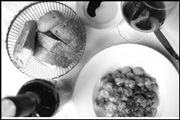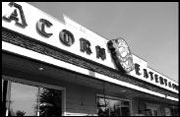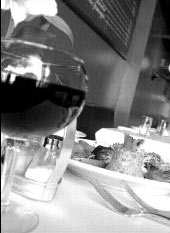IL FORNAIO 600 Pine St., DOWNTOWN 206-264-0994, www.Ilfornaio.com Restaurant and Risotteria: 11:30 a.m.- 10 p.m. Sun.-Thurs.; until 11 p.m. Fri.-Sat. Panetteria: from 6:30 a.m. Mon.-Fri. Caffe: 9 a.m.-8 p.m. Mon.-Thurs.; until 9 p.m. Fri.-Sat.; 10 a.m.-6 p.m. Sun.
Pacific Place is the retail center of Seattle’s near-dead Internet Wonderland economy. Originally described by its designers as “a world alive with the pulse of the city and culture unique to the Pacific Northwest,” the tone of the place shows up better in the crazed Downtown Reno Ski Lodge look of the multiplex upstairs.
But in the midst of high-turnover identibrands like Tiffany and Cartier, there’s one happy surprise—more accurately, four happy surprises. In the world of ethnic chain-restaurant eating, “authentic” is usually a synonym for “crap.” But Il Fornaio not only gets it right, they do it local style.
Only a chain (there are currently 23 Il Fornaios, most of them in California) would attempt four separate outlets in one mall. The main attraction upstairs offers formal service with slightly higher prices, suggests reservations, and features monthly specials that focus on specific Italian regions. Frequent visitors earn points toward freebies, and the specials usually include a gratis dessert or appetizer.
Downstairs is the Risotteria, more casual, with a nightly special that may be the best deal in town (three courses, each with a generous glass of wine, for $20.95 or $18.95 without wine). A quick bowl of soup, sandwiches, and pastries are available from the adjoining Panetteria, which does a brisk morning business. And the atrium itself houses a simple cafe, a convenient spot to rest feet and raise blood sugar in the midst of shopping. House-brand cookbooks, glassware, oils, and vinegars are also on sale: Chain restaurants are good at cushioning that bottom line.
A little about the company before we get to the food: Any chain can call its lead chefs “partners” and not do anything more than throw an extra buck in the quarterly bonus. At Il Fornaio, “chef partners” are expected to procure local in-season supplies and build the menu around them, catering to local tastes. This may be the only chain that puts quality over consistency; stop in at, say, the Denver Il Fornaio, and it’s entirely possible you won’t find the same minestrone, pasta fillings, or pesto variations you love so much downtown. And to that, we say “hurrah!”
THE HEART OF an Italian restaurant is the pasta, and the heart here pumps with passion; all fresh pasta is made in-house, all dried is imported from Italy. Lasagne ($11.95) is a luxurious mound of noodles, b飨amel, and Bolognese, piled with ricotta creamy as custard.
A bowl of fettucine with Bolognese ($10.95) will remind a paisan of grandma. Tasty chunks of beef and fennel-sweet Italian sausage in rich tomato sauce add up to a hearty bowl of memories, even if it’s not the completely melded perfection it should be. Gnocchi comes with the same chunky sauce or pesto ($13.95). They are smooth and light, and made an excellent centerpiece for the Risotteria’s three-course special. Ravioli ($14.95) is the only consistent disappointment—on two widely spaced occasions, they were filled with apparently unflavored dry breadcrumbs.
Breads and pastries are also made in-house. It’s easy to munch right through the complimentry basket of bread before your order even arrives. The focaccia and Sicilian sesame loaf (Risotteria and Il Fornaio, respectively) are soft-textured and fluffy, while crustier items like the little olive rolls round out the basket nicely. (Most all the breads are available from the downstairs bakery, often selling out before the close of business.)
Desserts aren’t always successful. A cannoli and profiterole combo—free with an entr饠chosen from upstairs’ Sicilian menu—failed to impress. The cannoli’s rich filling would’ve been excellent if it hadn’t only filled the ends, leaving empty crispy shell in the middle. The profiterole (think miniature cream puff) had been made earlier and frozen—we chipped away impatiently for several minutes before it softened up.
Meats are also part of the menu, but if the steak (the main entr饠of our three-course special) was typical, they are best avoided. Pan-fried and cooked rare as ordered, one end had a distinctly unpleasant aura of grilled fish. Most likely a sign of a poorly cleaned grill, it was the only disappointment in the $21 deal. The appetizer—a stuffed mozzarella slab filled with proscuitto, basil, and pine nuts, was absolute heaven in its creamily fragrant richness.
Another sign of big-time chain buying power is found on the wine list; Il Fornaio offers three house cuv饳, starring a Chianti ($7) and pinot grigio ($5.50) designed for universal appreciation—light, fresh, supremely easy to drink. Those who crave more unusual varieties have plenty to choose from in any location. One prosecco was bottled ” with the traditional crown bottling” and described as ” lightly carbonated.” Four members of the staff joked about its “traditional” bottle cap and the near-complete lack of bubbles. It wasn’t bad, but not in the least what you’d except from a fruity prosecco.
“Not in the least what you’d expect” also nicely sums up Il Fornaio—even the cookbook (by executive chef Aurizio Mazzon) is good: Try the great, simple pizza crust. A chain more committed to “local” than many local places? A restaurant in a mall that has real elegance? Upstairs or down, we say meraviglioso!









